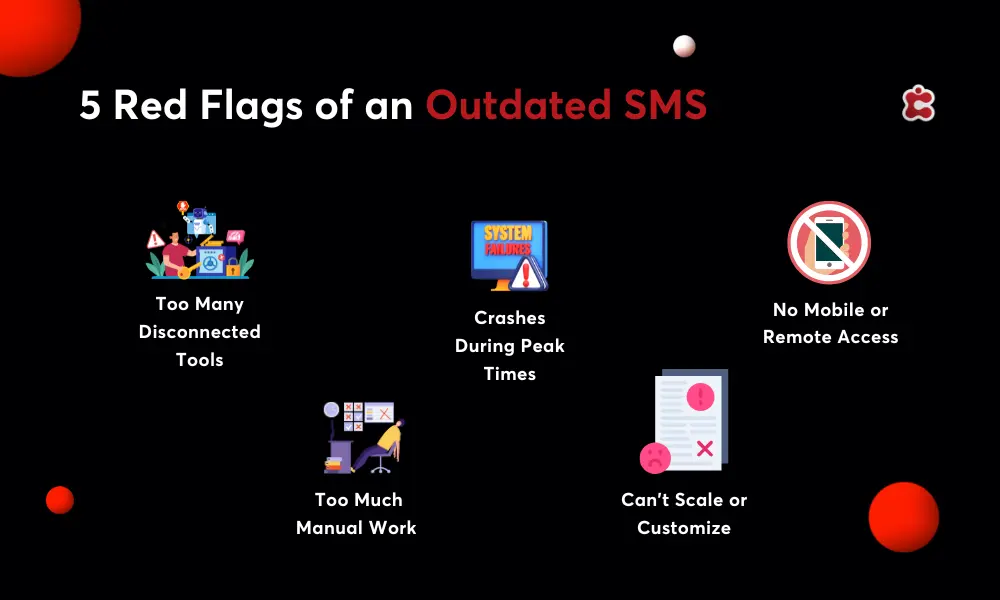Colleges don’t stand still. From expanding academic programs to welcoming more students, growth is part of the journey. However, as your institution evolves, so should your technology. If you’re still relying on outdated school software, you might be feeling the friction of slow processes, scattered data, and frustrated staff.
The right school management software for colleges should support your daily operations, simplify communication, and help everyone (from administrators to students) stay on the same page. If your current solution feels more like a burden than a benefit, you’re not alone.
In this article, we’ll walk through five clear signs that your college has outgrown its higher education SMS. If even one of these hits close to home, it might be time to explore a more modern, unified system built for where your institution is headed next.

Sign 1: You’re Using Too Many Tools That Don’t Connect With Each Other
If your admissions, grading, scheduling, and billing systems all live on different platforms, it’s a clear sign your college has outgrown its current school management software. What might have worked in the past now leads to daily inefficiencies that slow everything down.
When your systems aren’t connected, you run into major problems:
- Duplicate data entry — Staff spend hours inputting the same information across multiple platforms.
- Inconsistent records — A change made in one system might not reflect elsewhere, leading to errors.
- Slow reporting — Generating insights takes longer when data is scattered.
- Miscommunication — Departments operate in silos, making collaboration more difficult.
- Higher IT burden — Your tech team is constantly troubleshooting and maintaining multiple tools.
These disconnected workflows not only waste valuable time but also increase the risk of compliance issues, especially around student data and academic reporting.
A modern school management system should unify your internal processes. It should connect easily with external tools like learning management systems (LMS), financial platforms, and communication apps. Switching to an all-in-one school management software for colleges makes a significant difference. With a unified system, data flows seamlessly between departments, tasks are automated, and staff can access the same up-to-date information in one place. It simplifies operations, strengthens collaboration, and gives your college room to grow without the tech headaches.
Sign 2: Your System Crashes or Slows Down During Peak Periods
Does your system freeze every time registration opens? Do staff complain about slow load times during grading week? If your school management software struggles to keep up during the most important times of the academic year, that’s a clear sign it’s no longer meeting your college’s needs.
Lagging performance during peak periods is more than just a technical glitch. It’s a signal that your software wasn’t designed to handle your current volume of data, users, or activity. As your institution grows, so does the demand on your system, and if your SMS can’t scale with you, it becomes a bottleneck.
Here’s why it matters. Crashes or delays during key processes like course enrollment or exam scheduling lead to frustrated students, overwhelmed staff, and a growing pile of support tickets. It can also cause serious disruptions in academic timelines and erode trust in your internal systems.
Upgrading to a cloud-based school management software gives your college the flexibility and scalability it needs. With real-time access, automatic updates, and reliable performance even under pressure, cloud systems can easily support thousands of users at once.
Sign 3: You’re Missing Mobile or Remote Access Features
Today, there is an app for everything. Everyone is on their phones—checking schedules, sending messages, managing tasks—and your students and staff expect the same convenience when it comes to academic life. If your current school management software doesn’t offer reliable mobile or remote access, it’s a major limitation.
In higher education, flexibility is key. Students want to check grades, submit assignments, and view timetables from anywhere. Faculty and admin teams need to access data on the go, whether they’re working remotely, teaching in different buildings, or supporting students outside of office hours.That’s why having a dedicated mobile app—like the one offered by Classter—is so important. A well-designed app provides students and staff with a seamless experience, offering real-time updates, push notifications, and secure access to academic information directly from their phones. It consolidates everything in one place, enhances responsiveness, and enables your college to deliver a more connected and modern campus experience.
Sign 4: Your Staff Is Still Doing Too Much Manually
Are your teams still relying on spreadsheets to build class schedules, calculate grades, or compile reports? If so, your current school management software is holding your college back. Manual workflows might have worked when operations were simpler, but they’re no match for the demands of a growing institution.
Manual processes come with a cost. They increase staff workload, slow down key operations, and leave room for human error. A single typo in a spreadsheet can impact a student’s academic record or throw off your reporting. Plus, these time-consuming tasks leave your team with less energy to focus on what really matters—supporting students and improving outcomes.Today, automation is no longer a luxury. It’s a necessity for institutions that want to scale efficiently and maintain accuracy. That’s why investing in school management software with automated workflows can be a game-changer. It helps your team move faster, stay organized, and reduce repetitive tasks—freeing them up to focus on strategy, innovation, and student support. Less manual work means more time for meaningful impact.
Sign 5: You Can’t Scale or Customize as Your Needs Change
Higher education is constantly evolving. New academic programs, departments, student services, and partnerships are part of growth. But if your current school management software can’t keep up with those changes (or worse, blocks you from adapting), it’s a clear sign you’ve outgrown it.
A rigid SMS limits your institution’s ability to innovate. Whether it’s launching an online program, managing a dual-degree structure, or supporting international students, you need a system that can be tailored to fit your unique processes. If adding a new workflow or user group requires workarounds, custom coding, or vendor intervention every time, it’s not sustainable.That’s where modular architecture makes all the difference. A flexible, modular school management system allows you to pick and choose the features you need, when you need them. Want to start with admissions and expand into billing or academic tracking later? No problem. As your college evolves, your SMS should scale alongside you, with the freedom to customize as much or as little as you want. The result? A future-proof system that supports long-term success.
Don’t Let Outdated Software Hold You Back
If any of these signs feel painfully familiar, your current school management software may be doing more harm than good. Classter is an all-in-one School Management System built specifically for higher education institutions that want to unify their tools, reduce admin burden, and deliver a better student experience.
With Classter, you get a flexible, modular platform that covers everything from admissions and academics to billing, scheduling, and student engagement. It’s fully cloud-based, mobile-friendly, and designed to support hybrid and remote learning environments. You can automate routine tasks, streamline workflows, and gain real-time insights that help you make smarter decisions.
Ready to future-proof your campus? Discover how Classter can simplify your operations and support your growth.
FAQ’s
The best software is flexible, cloud-based, and scalable—like Classter, which unifies admissions, academics, billing, and student engagement in one platform.
Yes, with the right provider. Classter offers guided onboarding, data migration support, and training to make the switch smooth and low-risk.
Look for automation, mobile access, reporting tools, modular functionality, and integration with LMS, CRM, and financial systems for complete campus management.

